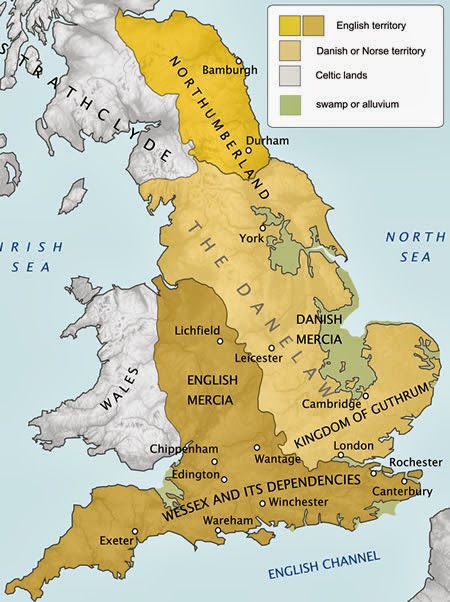 |
| Danelaw |
Danelaw encompassed the areas of northeast England where Danish customs had a strong political and cultural influence throughout much of the early Middle Ages. The area included Yorkshire (southern Northumbria), East Anglia, and the Five Boroughs, named for its main centers of settlement: Lincoln, Stamford, Nottingham, Leicester, and Derby.
All these territories bore influence of Scandinavian culture from Viking invaders in the late-ninth century, who then became settlers and who drove the political leadership of the Anglo-Saxon kingdoms into retreat to the south and west.
In c. 865 an army of between 500 and 1,000 Vikings arrived in England and began a systematic attack on the island. Their leaders were three brothers, Ivar the Boneless, Ubbi, and Halfdan, who had allegedly come to avenge the death of their father, Ragnar. They secured horses in East Anglia and proceeded to York, finding that infighting among local Anglo-Saxon leaders made conquest easy in Northumbria.
  |
The invaders next attacked west into Mercia and by 869 defeated East Anglia. The following year Halfdan attacked the kingdom of Wessex, seizing Reading and fighting nine pitched battles against Wessex. The Anglo-Saxons won only one battle, and the onslaught devastated the ranks of their nobility. Despite their unequivocal success, when Wessex offered a treaty the Vikings readily agreed and refocused their efforts north toward the kingdom of Mercia.
Throughout the 870s the Danish army continued to conquer territory in England, dividing and redividing the lands they acquired. They split Mercia with a puppet Anglo-Saxon king, Ceowulf, who held the territory on their behalf from 874 to 877 while they completed their conquests.
However by 876 Halfdan and his men had occupied and divided Northumbria, settled into farming, and started a permanent settlement. In effect, the Danes had politically removed Yorkshire, Nottinghamshire, Lincolnshire, Derby, and Leicestershire from the rest of England.
Historians believe that the Danish settlement proceeded in two waves and probably did not displace the English people living in the area. The first wave of Danish settlers came as invaders, increasing in number over time. The second wave came as emigrants from Denmark, who settled in the areas protected by the military forces of the first wave, and who subsequently pushed colonization into new areas.
Early in the winter of 878 a Viking leader named Guthrum launched an attack on the kingdom of Wessex, catching it almost completely off guard and forcing its king, Alfred the Great (r. 871–899), to retreat to the island of Athelney. The Vikings proceeded to conquer the lands of Wessex, while Alfred gathered support and built reinforcements in the southwest, preparing for a counterattack.
Later in the year Alfred defeated the Danes at Eddington and drove them back to Chippenham. Eventually Alfred and Guthrum settled their differences and established a treaty for what would become the Danelaw, the main boundary for the division between English England and Anglo-Danish England.
The area became a kind of “Denmark overseas,” which Danes organized and administered and which was different from the rest of England in ethnicity, culture, law, language, and social custom. Although the formal division lasted only about five years, through the 11th century Danish law and customs prevailed in this area and the rulers continued to recognize the special and separate nature of Danish England.
The term Danelaw first appears in the time of Canute (1016–35) to distinguish the area’s different legal system, but it is incorrect to categorize Danelaw as a homogeneous territory. The differences in custom, law, and political allegiance varied with the density of the Norse population, but the area’s internal divisions never trumped its separateness from English England.
The Scandinavian language permeated the area, as is most commonly observed in the frequent place names ending in by or thorp. Cultural differences also appear in land tenure. Rather than dividing their land into units known as hundreds used to administer the English shires, Yorkshire and the Five Boroughs settlers divided their land into units known as wapantakes.
The term, never used in Scandinavia, is related to “weapon taking,” the Viking custom of brandishing one’s weapon to show approval of council decisions and is unique to the Danelaw. Likewise, they divided agricultural land into ploughlands, rather than using the Anglo-Saxon unit known as hide.
The Danelaw’s legal codes also showed a great deal of Scandinavian influence, not only in terminology but in concepts that differed from those of Anglo-Saxon England. For example, in the Danelaw, wergild fines related to a man’s rank, rather the rank of his lord, and the laws punished violations against the king’s peace more severely than in English territories. Courts and legal assemblies reflected Scandinavian roots as well.
To investigate crimes, 12 thegns in each wapentake formed a jury of presentment, and the opinion of the majority prevailed in making its decision. They ultimately settled the fate of the accused by ordeal, as in Anglo-Saxon areas, but the notion of a jury of locals charged with investigating a crime was not an Anglo-Saxon concept.
Historians note the positive influence of the Scandinavian culture on the island, from the intensification of agriculture that made Lincolnshire, Norfolk, and Suffolk among the most prosperous shires of the period and the political success of King Canute to the regular commerce that emerged in the North Sea. Although the formal boundary of the Danelaw lasted only a few years, the impact of the Danes on England’s culture, economy, and political system remained strong throughout the Middle Ages.